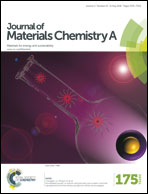A 3D porous Li-rich cathode material with an in situ modified surface for high performance lithium ion batteries with reduced voltage decay†
Abstract
High crystallinity Li-rich porous materials integrated with an in situ formed surface containing carbonaceous compounds are synthesized through a facile approach. The rationally designed procedure involves the formation of a specific morphology of a hydroxide precursor assisted by a self-made template and subsequent high temperature treatment to obtain a Li1.2Mn0.56Ni0.16Co0.08O2 target product. The porous morphology is investigated using field-emission scanning electron microscopy and its surface area is quantitatively examined by gas sorption analysis coupled with the Brunauer–Emmett–Teller method. The crystallinity is characterized by X-ray diffraction and high-resolution transmission electron microscopy. X-ray photoelectron spectroscopy, CHN elemental analysis and small angle neutron scattering confirm the presence of carbonaceous compounds in the surface composition. The prepared material exhibits superior discharge rate capability and excellent cycling stability. It shows minor capacity loss after 100 cycles at 0.5C and retains 94.9% of its initial capacity after 500 cycles at 2C. Even more notably, the “voltage decay” during cycling is also significantly decreased. It has been found that carbonaceous compounds play a critical role in reducing the layered to spinel structural transformation during cycling. Therefore, the present porous Li-rich material with surface modified carbonaceous compounds represents an attractive material for advanced lithium-ion batteries.


 Please wait while we load your content...
Please wait while we load your content...